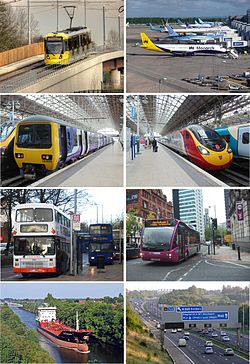Transport
 From Wikiversity - Reading time: 3 min
From Wikiversity - Reading time: 3 min

Transport (commonly used in the U.K.), or transportation (used in the U.S.), is the movement of humans, animals and goods from one location to another. In other words, the action of transport is defined as a particular movement of an organism or thing from a point A (a place in space) to a point B. Modes of transport include air, land (rail and road), water, cable, pipeline and space. The field can be divided into infrastructure, vehicles and operations. Transport enables trade between people, which is essential for the development of civilizations.
Transport infrastructure consists of the fixed installations, including roads, railways, airways, waterways/air routes, canals and pipelines and terminals such as airports, railway stations, bus stations, warehouses, trucking terminals, refueling depots (including fueling docks and fuel stations) and seaports. Terminals may be used both for interchange of passengers and cargo and for maintenance.
Vehicles traveling on these networks may include automobiles, bicycles, buses, trains, trucks, helicopters, watercraft, spacecraft and aircraft.
Learning Tasks
[edit | edit source]- (Transport processes in particles and molecules) Above, transport processes are mentioned in the context of logistics. However, transport processes also occur at the molecular level or at the particle level. Analyse both transport processes and identify similarities and differences (see also diffusion).
- (Risk management) In risk management, one must provide resource in a way that covers risks as well as possible. Explain the importance of transportation processes in risk management.
- (Water) Examine transportation processes in the context of drinking water. This includes not only human water supply, but also other aspects of water transport from an environmental science or meteorological perspective.
- (Biology) During metabolism in the human body, substances are absorbed, processed, and excreted. Which transport processes in the human body are you familiar with and what are the similarities and differences to logistics in the field of economics.
- (Sustainable Development Goals) Consider the Sustainability Goals of the United Nations and identify in the individual goals the role that transport processes play in this context[1].
- (Intermodal Public Transport) Intermodal transport of goods by containers has become an integral part of transportation and logistics. Transfer the concept to a theoretical concept of an intermodal public transport in which
- Passenger compartment/cabin
- Propulsion unit
- are considered as separate units that can be recombined on a trip from A to B on ships, railways, ... . Discuss the impact of such an approach on the Sustainable Development Goals. How does transportation support sustainability or creates drawbacks for sustainable accomplishment of a specific goal! E.g.
- less consumption of resources due less required reusable public propulsion units.
- resusabilty of passenger cabins even if the propulsion unit is outdated,
- a trailer for passenger cabins for a bus allows integration into current public transport concepts.
- Identify requirement and constraints of such a theoretical public transport approach with intermodal passenger cabins.
- (Interoperability) Analyze the concept of interoperability and discuss that in the context of an interoperable public transport. What are benefits and drawbacks of the current public transport you know and how can passenger e.g. with their baggage can easier change vehicles. What are the contributions of shared economy to interoperability and what are the difference of public transport that shared the same operational standards at interface (see also interoperability)!
See also
[edit | edit source]- Interoperability
- Wikipedia:Transport
- Diffusion and Osmosis
- Risk management - transport resources for risk mitigation according to risk maps
- Water and Water Supply Management
- Sustainable Development Goals
- Intermodal Public Transport
- Data analysis
References
[edit | edit source]- ↑ Mihyeon Jeon, C., & Amekudzi, A. (2005). Addressing sustainability in transportation systems: definitions, indicators, and metrics. Journal of infrastructure systems, 11(1), 31-50.
Page Information
[edit | edit source]This page was based on the following Wikipedia source page:
 KSF
KSF